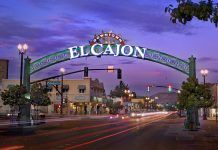Economists and behaviorists agree that the past is the best predictor of future occurrences. What has happened before can, and likely will, happen again.
Economists and behaviorists agree that the past is the best predictor of future occurrences. What has happened before can, and likely will, happen again.
Criminal justice specialist Ivy Westmoreland brought that truism to life at the Lemon Grove Historical Society’s first 2015 meeting in the History Alive presentation series keyed around the theme of “The Future of Lemon Grove.” The evening gathering on Jan. 8, at the historic H. Lee House attracted a packed room of about 30 attendees. Westmoreland titled her informational speech “Crime in the Big Lemon.”
Should residents of Lemon Grove fear that in 2015 they will fall prey to criminals?
Westmoreland served as a regularly attending member of Lemon Grove’s Public Safety Focus Group, established by the city council at the beginning of 2014. She brought facts, figures, observations and recommendations gleaned from the focus group’s studies, providing a summary to the historical society members about which crimes to expect in this coming year.
The first important fact Westmoreland cited is that the Lemon Grove business district suffers from substantially more criminal activity than residential areas of the city. Around 65 percent of the reported crimes occur in the commercial corridor including the trolley station area and streets near Broadway and Massachusetts Avenue. She urged that those living in Lemon Grove should feel safe, rather than succumb to any misperceptions that the town is a risky place to live in.
A second set of striking observations from the Public Safety Focus Group’s collected data are related to the types of crimes that are being committed. Most Lemon Grove criminal acts fall into the classification of property crimes, such as thefts and vandalism. For example, of 26 calls to law enforcement in September, 30 percent were about trespassing and suspicious activity, while 40 percent were related to substance abuse problems. Over the most recent seven-year period with available statistics, property crimes reached the highest level in 2008 and fell lowest in 2011. For 2014, nearly half the property crimes involved shoplifting, mostly at Home Depot.
And as property crimes have been diminishing, violent crimes have been rising. But that is no harbinger of serious danger, according to Westmoreland. Nearly all people victimized by violent criminals, such as murderers or robbers, know the person committing the crime. “Very little violent crime is random,” she said.
She discussed the most recent murder committed in Lemon Grove, misreported as a homicide of a homeless man. The 58-year-old victim instead had been living with his brother. Police are now convinced that his killing was gang-related, because he had run afoul of gang members living across the street from his brother’s house.
The focus group consolidated broad generalizations about problem areas, challenges and possible effective solutions. The identified “three major challenges” include condition of the physical environment, intimidating groups and lack of community involvement in engaging to resist problems. Trouble spots have to do with outsiders coming into Lemon Grove, with homeless persons and with residents of group-living homes. “If you don’t stand up as a community, these others will take over,” Westmoreland informed the audience.
Reported problems with homeless people were highest in 2010, then about halved by 2013. One solution for this would be an educational campaign about how residents should respond to vagrants, panhandlers and beggars, so that people “learn how to say no,” in Westmoreland’s formulation. Another approach could be adoption of an anti-panhandling ordinance.
About four-dozen group homes are scattered throughout Lemon Grove. That is a hazardous offshoot of the housing recession. When many homeowners defaulted and lost their houses, a significant number were purchased and transformed into group homes, such as halfway houses for former convicts or those in recovery from drug and alcohol abuse. These group homes are controlled under state regulations, not Lemon Grove ordinances and codes, and the city has no formal registry listing them. From July 2013 through 2014, the 242 service calls answered by the fire and sheriff’s departments were mostly to unlicensed facilities. Group homes in this regard, at $60 and $225 per call, respectively, cost Lemon Grove an estimated $74,000. Another educational campaign, targeted toward teaching how to identify and report crimes is a possible response to such problems. The city could also consider penalties fined against repeat offenders among group home operators, who have received warnings about multiple service calls to their facilities.
Westmoreland cautions against leaping to the easy conclusion that the answer is hiring more law enforcement officers. Westmoreland says Lemon Grove is now well protected and served by the existing arrangement of five sheriffs and two reserve officers during daytime hours, with two regular officers and a sergeant on night duty. Putting another sheriff on the payroll would cost $194,000, which the focus group determined was very expensive, especially when the members concluded that the problems could be handled in “more beneficial ways.”
General solutions come in the form of the three “E’s,” which stand for enforce, educate, encourage (on saying no) and expose (repeat offenders) and the approach the group recommends is pro-active and directly targeted. Keep the physical environment in good condition, urge businesses and property owners to use adequate lighting and to keep landscaping and foliage tidy and well maintained. Non-responsive owners with deteriorating premises can be further encouraged toward better clean-up efforts through contacting code enforcement officers to intervene. Businesses can also be informed about the benefits of posting anti-trespassing signs, hiring more private security guards and reporting crimes quickly.
Neighborhoods can be encouraged to pull residents together, to sign petitions to install more street lights. The current cost for a homeowner for the improved lighting of one street lamp is $12 annually. “Know your neighbors. This is the best Neighborhood Watch you can have,” Westmoreland said.
Interventions with apartment complexes and group homes can build on an existing multi-housing program for prevention. Volunteers could be enlisted to participate in visiting the sites and reaching out to the owners and managers.
Another possibility is establishing a combined anti-crime storefront and resource center, modeled after one in the City Heights community in San Diego. Such a facility handles non-emergency matters, makes referrals to relevant agencies, and assists with sharing information and filling out official paperwork for submission to the city. “This could work for us too,” Westmoreland said.
She ended with a plea for coming together as an actively involved community. “Get your neighbors interested. Strap on a pair of boots.”














